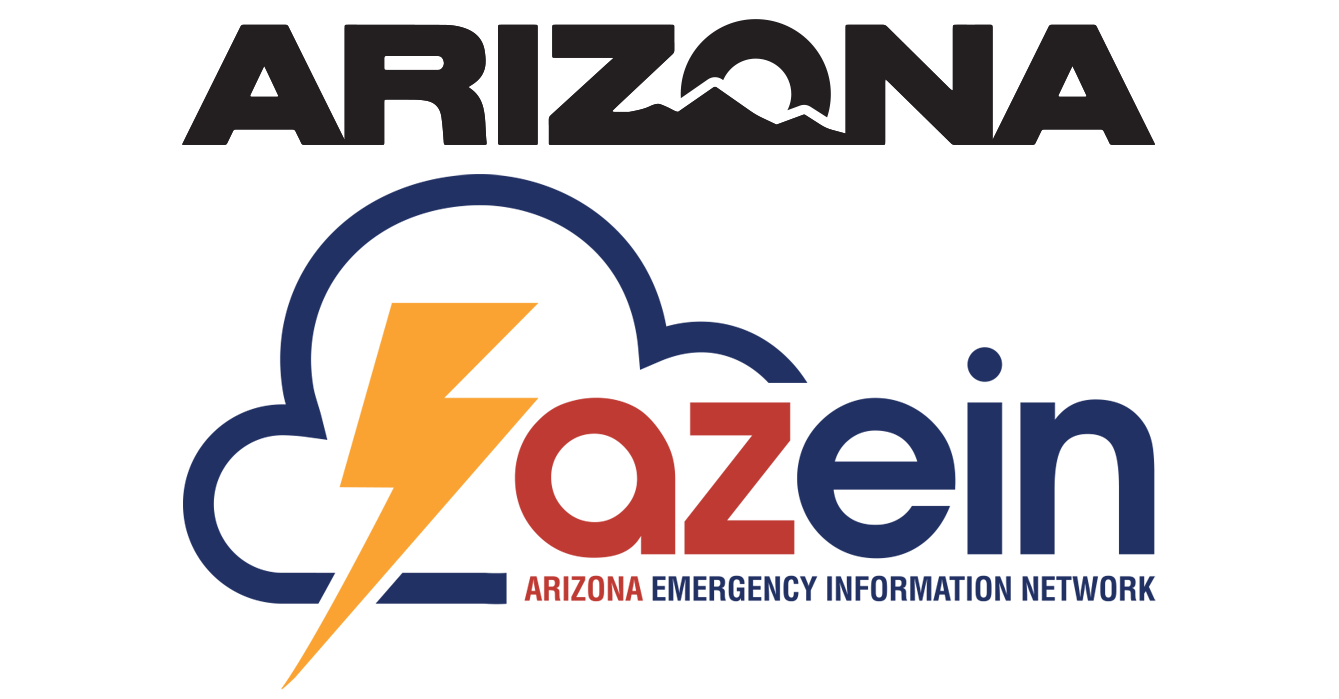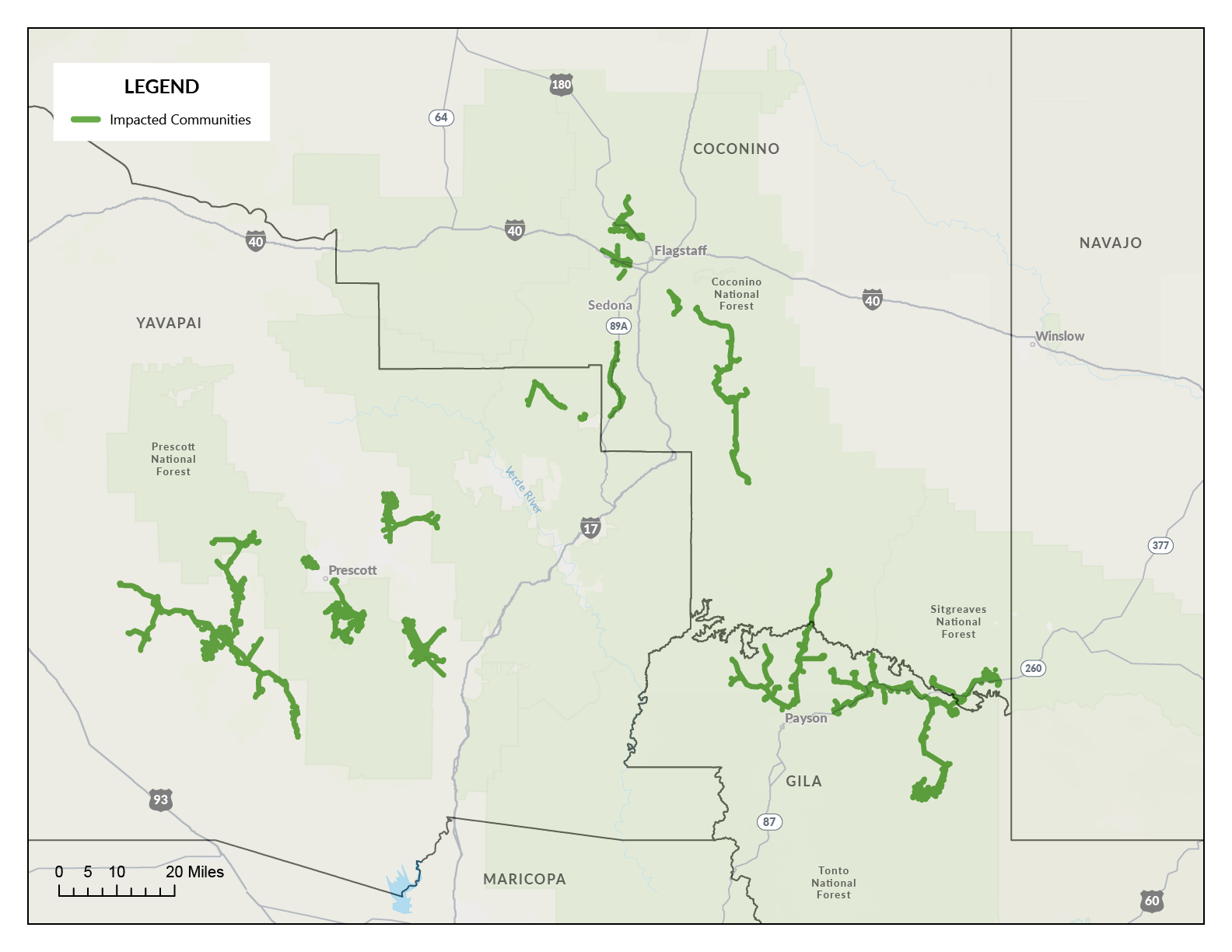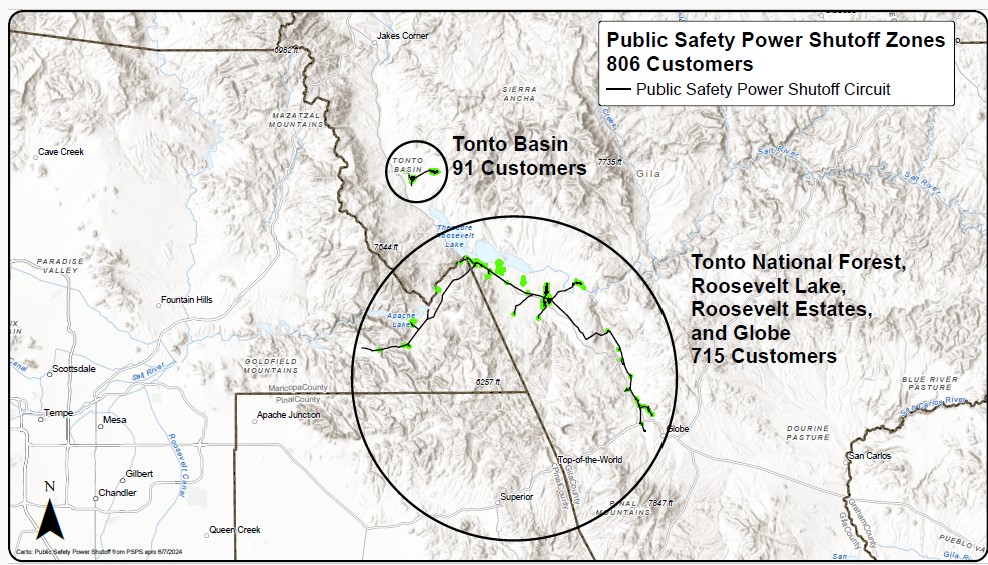Public Safety Power Shutoff
Every year, extreme fire weather conditions threaten our homes, our lives, and the electrical system. Power companies have a new program to protect people and property, called Public Safety Power Shutoff (PSPS).
PSPS is already being used in other states. In Arizona, PSPS will only be used in limited and targeted communities and ONLY if weather conditions create an extreme fire risk. The goal is to prevent wildfires and support public safety.
This year, some APS customers in Yavapai, Coconino, and Gila Counties and some SRP customers in the communities of Roosevelt Estates, Roosevelt Lake, Tonto Basin and Globe may experience a PSPS.
If you live in an area that has been identified for the potential for PSPS, you should have been notified from your power company. Make sure your power company has your current contact information to ensure you receive Public Safety Power Shufoff notifications.
- APS PSPS information and APS customer account login
- SRP PSPS information and SRP customer account login
APS impacted communities
A Public Safety Power Shutoff could impact customers in the highest fire-risk communities located in northern Arizona. These communities include parts of Coconino, Gila and Yavapai counties.
SRP impacted communitiesPublic Safety Power Shutoff could impact customers in the highest fire-risk communities located in Roosevelt Estates, Roosevelt Lake, Tonto Basin and Globe.
How PSPS Works
- Monitoring conditions: power companies closely monitor fire weather conditions, including wind speed, humidity levels, and vegetation conditions.
- Decision to shut off power: when conditions become extreme, power companies may decide to shut off power in targeted areas to prevent wildfires. The decision to shut off power is based on several factors, including weather and vegetation conditions.
- Notification: customers in participating limited areas will be notified by their electrical utility in advance of power being shut off temporarily. Notifications may be sent via email, text messages, automated phone calls, and the utility's website. It is crucial for customers to ensure their account contact information is up-to-date to receive alerts from their provider.
- Power restoration: power will be restored once it’s safe to do so. The length of a PSPS event depends on how long the weather conditions last and the time it takes for crews to physically inspect the de-energized power lines for debris and damage after the weather conditions subside. The outage may last longer if repairs are needed.
Potential Impacts of PSPS:
- Loss of water and wastewater distribution systems
- Loss of perishable foods and medications
- Loss of heating/air conditioning and electrical lighting systems
- Loss of computer systems, telephone systems, and communications systems
- Loss of public transportation systems
- Loss of fuel distribution systems and fuel pipelines
- Loss of all electrical systems that do not have back-up power
Preparation and Resources
Before
- Update contact information: ensure your contact information is current with your electrical utility to receive timely alerts.
- Create an emergency go kit: include essentials such as water, non-perishable food, flashlights, batteries, a first aid kit, medications, and important documents.
- Develop a communication plan: have a plan for how you will communicate with family and friends during a power outage.
- Backup power: consider investing in a generator and ensure it is properly maintained. Have fuel on hand but store it safely.
- Charge devices: keep mobile phones, laptops, and other electronic devices fully charged.
- Medical needs: if you rely on medical devices that require electricity, plan for alternatives such as battery backups or relocation.
- Prepare your home: install surge protectors to safeguard electronics, and know how to manually open your garage door.
- Plan for refrigeration needs: keep ice packs in your freezer to help keep food cold longer during an outage.
- Additional power outage tips
During
- Stay informed: monitor local news and your utility’s website or app for updates on the status of the outage and when power is expected to be restored.
- Conserve battery power: use devices sparingly to conserve battery life. Turn off non-essential electronics.
- Avoid opening refrigerators and freezers: keep doors closed as much as possible to maintain the cold temperature and preserve food.
- Use backup power safely: if using a generator, ensure it is operated outside and away from windows to prevent carbon monoxide poisoning.
- Check on neighbors: particularly the elderly, those with young children, and those with medical needs, to ensure they are safe and have what they need.
- Follow safety protocols: use flashlights instead of candles to reduce the risk of fire.
After
- Inspect your home: once power is restored, check your home for any damage. Ensure all appliances and electronics are functioning properly.
- Restock your emergency go kit: replace any items that were used during the outage and check expiration dates on food and medications.
- Replenish supplies: restock fuel for generators and batteries for flashlights and other devices.
- Review and update plans: evaluate your preparedness plan and make any necessary adjustments based on your experience.
- Stay informed: keep up to date with your utility provider for any further PSPS events and updates on measures to reduce the need for future shutoffs.
Resources
- APS Public Safety Power Shutoff (PSPS)
- SRP Public Safety Power Shutoff (PSPS)
- Public Safety Power Shutoff (PSPS) video (English, ASL)
- Corte de Energia Para la Seguridad Publica (CESP) video (Spanish)
- Power Outage video (ASL)
- Power Outage Preparedness



